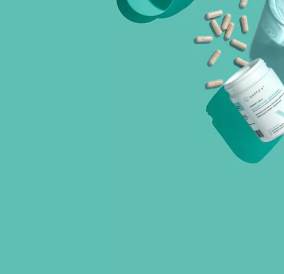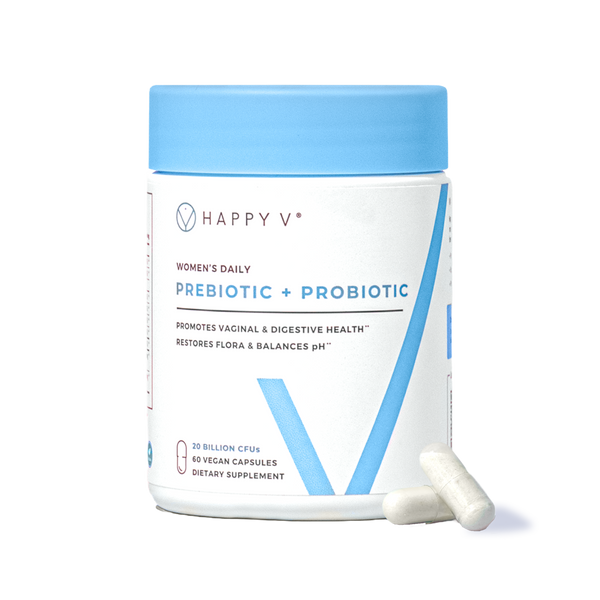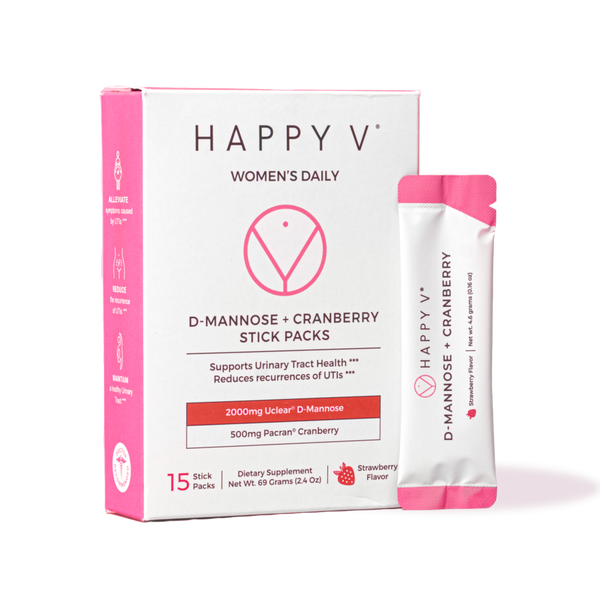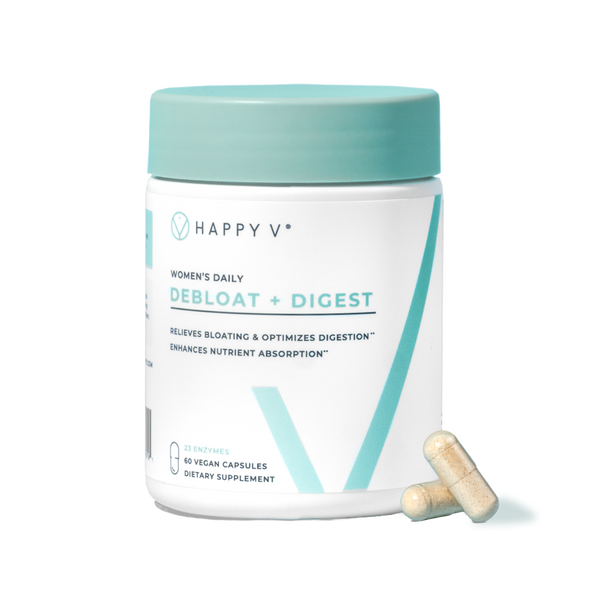- Fact Checked
- August 01, 2023
- 13 min read
Table of Contents
So how can stress cause BV, you ask? Before we answer that, let’s have a quick refresher on BV; BV is a common condition when there’s an overgrowth of harmful bacteria in your vagina. Usually, there’s a healthy balance of “good” and “bad” bacteria in the vaginal flora, and there are enough good bacteria that can offset the effects of harmful bacteria present; but when the bad bacteria outnumber the good, that’s when BV happens.
Bacterial vaginosis symptoms can vary from person to person, but the most common signs you may experience can include abnormal vaginal discharge, odor, itching, and pain.
While the symptoms of BV and vaginal yeast infections, or candidiasis, can be similar, it’s important to note that both are different forms of vaginal infections requiring different treatments. BV is bacterial, so it’s typically treated with antibiotics or other prescribed medications, whereas yeast infections are fungal, so it’s treated with antifungal creams.
Regarding the correlation between stress and bacterial vaginosis, It’s important to remember that stress cannot directly cause BV; however, it can lower your immune system and make you more susceptible to infection.
In many cases, the exact cause of BV is unknown because it can be triggered by multiple factors that throw off the pH level of the vaginal flora. The optimal pH ranges are from 3.8-4.5. However, health issues may occur when the pH rises or falls past the optimal range.
For this reason, finding ways to naturally treat and prevent BV is essential. One of the most natural and holistic things you can do to improve your body’s ability to deal with BV infections is to optimize the immune system, and there is a very clear link between your immune health and stress. So let’s talk about ways to manage your stress with the hopes of supporting a healthy vaginal flora.
The Link Between BV and Stress
There may be a correlation if you’re dealing with recurrent BV infections and struggling to keep stress at bay. Research has shown that poorly managed stress can weaken the immune system and increase the likelihood of BV infections.2 Here are a few findings that back up these claims:
Women with perceived stress were 1.9x more likely to have BV than women with lower stress levels. A correlation was found between perceived stress and increased vaginal pH, which is associated with an increased risk of BV.2
When your body detects stress, it enters fight-or-flight mode, releasing the stress hormone cortisol. Chronically-high cortisol levels can lead to a slowed immune system, making inflammation and infection-onset more likely.3
And different types of stress can affect the body in different ways. A few of these include:
- Acute Stress. This is the most common type of stress that people experience and is typically a response to recent or anticipated events.
- Chronic Stress. Chronic stress is the type of stress that wears people away day after day, year after year. This stress can destroy your mental, physical, and emotional health.
- Environmental Stress. Environmental stress refers to physical, chemical, and other environmental factors that can cause stress and potentially harm an organism’s health or well-being. Environmental stress includes pollution, noise, overcrowding, natural disasters, and even daily weather conditions.
- Relationship Stress. Also referred to as psychosocial stress, relationship stress could be related to your spouse, family, or friends and might be caused by a lack of trust or poor communication.
- Internal Stress. Internal stress, or psychological stress, is caused by our inner perceptions, attitudes, or fears rather than by external events or circumstances. This can include worries about our health, performance at work or school, or self-esteem. It also encompasses stress from mental health conditions, such as anxiety disorders or depression. This stress is challenging to manage because it’s often self-generated and can persist even without external stressors.
Stress comes in many forms and can significantly contribute to several health issues. So let’s dive deep into this specific health issue—bacterial vaginosis.
What Is BV?
Let’s face it, no one likes to discuss bacteria in their vagina, but it needs to be addressed. Ensuring that the vaginal microbiome is healthy keeps our reproductive organs functioning optimally.
We all have different types of healthy bacteria, like lactobacillus species, growing in and around our bodies; the vagina is no exception. When pH in the vagina becomes more basic, certain harmful bacteria, such as Gardnerella vaginalis, can flourish and dominate, which may lead to this uncomfortable infection. Common symptoms of BV include:
- Gray or white vaginal discharge
- Abnormal vaginal odor
- Itching around the vulva
Pain when urinating
BV is not an STI, but it is one of the most common vaginal infections that women of reproductive age experience, and it is usually related to a trigger that throws off the pH of the vagina.
So, what can you do to help keep your vaginal pH levels balanced? Let’s explore some simple risk factors you can avoid to maintain the balance of bacteria and prevent BV from disrupting your life.
Sexual Activity
While bacterial vaginosis (BV) is not classified as a sexually transmitted infection, it can still be influenced by sex partners, which may increase the likelihood of BV infections. Understanding the relationship between sex and BV can help explain why symptoms may occur and how to minimize the risk.
Several studies have explored the association between sexual activity and BV, revealing compelling insights. For instance, one study found that Gardnerella vaginalis (the bacteria we previously mentioned that’s strongly associated with BV) was detected in 81% of sexually active women, compared to only 18% of sexually inactive women. This study suggests there’s potential that sexual activity may introduce the bacteria into the vaginal ecosystem, potentially leading to BV.4
And the evidence doesn’t stop there! Another study demonstrated that women who engaged in sexual activity within a two-week period were more prone to BV compared to those who abstained. New sexual partners and unprotected sex can introduce additional bacteria to the vagina and disrupt the delicate vaginal pH balance, increasing the risk of developing BV.5
During sexual activity, bacteria can accumulate in the vaginal flora, as well as in semen. Each has its pH level that can further impact the vaginal environment. These factors can disrupt the natural balance of good and bad bacteria, leading to the overgrowth of harmful BV-associated bacteria.
To reduce the risk of BV, it’s important to take certain precautions if you’re sexually active. Here are some recommendations to consider:
-
Practice safe sex by using condoms consistently and correctly. Condoms can help reduce the introduction of new bacteria into the vaginal environment. It’s essential to use condoms because it also helps with other potential issues like chlamydia and HIV (human immunodeficiency virus)
-
Limit your number of sexual partners. Every person has a unique microbiome; some are incompatible with others and can affect a woman’s microbiome. The more sexual partners you have, the more diverse the vaginal flora can become, causing complications.
-
Maintain good genital hygiene. Avoid using harsh soaps or douches that can disrupt the natural pH balance of the vagina. Your body has its natural defenses in lactic acid and hydrogen peroxide.
-
Consider using a pH-balanced lubricant. This can help maintain a healthy vaginal environment during sexual activity.
- Urinate before and after sexual intercourse. This can help flush out bacteria from the urethra and reduce the risk of urinary tract infections (UTIs) that may sometimes accompany BV.
Remember, these precautions are not foolproof but may help reduce the risk of BV associated with sexual activity. If you have any concerns or experience recurring BV symptoms, it’s important to consult a healthcare provider, like an ob-gyn (obstetrics and gynecology), for further evaluation and guidance.
Hormonal Changes
Hormonal fluctuations can alter the pH level of the vagina and make BV more likely. Changes in estrogen levels, such as those associated with pregnancy, menopause, or regular menstrual cycles, have been found to interfere with the pH of the vagina and increase your risk of developing bacterial vaginosis.6
But it’s not just natural hormonal changes based on life cycles. Another factor is the stress hormones released when your body is under physical or mental strain. Cortisol is a hormone produced by the adrenal glands in response to stress. While cortisol does not directly affect the pH of the vagina, chronic or prolonged stress leading to elevated cortisol levels can indirectly influence vaginal pH negatively.
The effects of stress can disrupt the balance of hormones in the body, including those that regulate vaginal health. Estrogen is a key hormone in maintaining the vaginal pH balance. Estrogen helps keep the vaginal environment slightly acidic, which is vital for maintaining the optimal balance of bacteria and preventing the overgrowth of harmful bacteria.
Elevated levels of cortisol due to chronic stress can interfere with estrogen production and utilization in the body. This disruption in the hormonal balance, specifically decreased estrogen levels, can result in a shift towards a more alkaline vaginal pH.
An increase in vaginal pH, from its typically acidic state (pH around 3.8 to 4.5) to a more alkaline environment (pH above 4.5), can create an environment that is less conducive to the growth of healthy bacteria and more favorable for the overgrowth of harmful bacteria, leading to conditions such as bacterial vaginosis (BV) or yeast infections.
So, the next time you’re feeling stressed out, remember to take some time for self-care for not only your vaginal health but your overall immune system, too!
Antibiotic Use
If you’ve recently taken antibiotics, this may increase your odds of developing BV. While antibiotics are often used to treat infections, they can also kill off the “good” bacteria in your vagina, disrupting the essential balance and allowing the “bad” bacteria to take over and ultimately leading to BV and the uncomfortable symptoms that come with it.
So, while antibiotics can be a lifesaver in some situations, it’s essential to be aware of their potential impact on your vaginal health. That’s why one study researched and discovered that women who had taken antibiotics in the last month were 1.5 times more likely to develop BV than those who had not.7
You may have to take antibiotics in certain scenarios, and that’s okay. When you have to take an antibiotic, the best thing you can do is pair it with a probiotic that’ll help reintroduce the good bacteria back into your microbiome.
If you’re in the market for a new probiotic, we recommend the Happy V Prebiotic + Probiotic. Take two of these capsules once daily, with or without food, and you’ll support your vaginal pH balance, restore good gut health, and improve your immune health.
Poor Hygiene Habits
Poor personal hygiene might make it more likely to develop BV. Without properly and regularly washing your vagina and genital areas, you can cause moisture and bacteria to build up, making you more prone to infection.
A study published in the Journal of Women’s Health found that women who washed the areas around their vagina less than once a day were more likely to develop BV when compared with those who washed once a day.8
Like the pH in your vagina, you must find the right balance when washing since over-cleansing the vagina can also be an issue.
Prevention and Treatment of BV
In some cases, bacterial vaginosis can resolve on its own. In more severe cases, prescription medications are sometimes required. Even after successful antibiotic treatment, the infection often returns later on once the bacteria begins to grow again in the vaginal flora.
Believe it or not, this is, unfortunately, very common. Luckily, there are some natural remedies that can help to prevent and treat BV.
By simply managing your stress and living a healthy lifestyle, you can support your overall health and lower your risk of BV. Here’s a list of additional symptom relief and prevention strategies for BV.
Probiotics
Studies have found that probiotics work as a natural method to help prevent BV. This daily supplement helps to give a healthy boost to the “good” bacteria throughout your body to support overall health.9 Another study published in the Journal of Women’s Health found that women who used probiotics containing Lactobacilli bacteria were less likely to develop BV than those who did not.10
If you’re in the market for a probiotic, we highly recommend our Prebiotic + Probiotic supplement. Made with eight clinically proven ingredients at their clinically proven dosages, this 100% natural probiotic works to balance vaginal pH, restore gut health, and improve immune health. Basically, it’s a no-brainer.
pH Balance
Your body’s pH level is determined by the balance of acids and bases in different areas of the body. The vagina, in particular, has a unique pH level that is slightly acidic, typically ranging from around 3.8 to 4.5. When the vaginal pH level becomes imbalanced and shifts towards being more alkaline, it can increase the risk of developing conditions like bacterial vaginosis. Keeping your vagina’s pH level balanced might help to prevent BV, so here are some practical ways to do so:
Avoid harsh soaps: Regularly washing the external genital area with mild, fragrance-free, and pH-balanced soaps or cleansers can help maintain the natural acidic environment of the vagina. Harsh soaps, douches, and scented products can disrupt the vaginal pH balance, so it’s best to avoid them.
Avoid douching: Douching involves using water or other solutions to rinse out the vagina. However, this practice can disturb the natural balance of bacteria and alter the vaginal pH. It is generally recommended to avoid douching as it can increase the risk of developing BV and other vaginal infections.
Take probiotics: You don’t say… (See how powerful a probiotic can be?!) As you know, probiotics help promote the growth of good bacteria, such as Lactobacillus. This then produces lactic acid, which can help keep the vaginal pH optimal. If you didn’t click on our Prebiotic + Probiotic supplement in the above section, here’s another reason to add it to your cart.
Condom Use
Even though BV is not an STD, condom usage can still help prevent infection. Studies have found that using condoms can make BV less likely.11 This might be because semen can alter the pH level of the vagina and make BV more likely. You see, semen has a different pH level compared to the vagina’s natural acidic environment.
The alkaline nature of semen can temporarily elevate the vaginal pH, which is normally acidic, making it more alkaline. This change in pH can create an environment favorable for the growth of harmful bacteria associated with BV, such as Gardnerella vaginalis.
The disruption of the natural pH balance in the vagina can contribute to the development of BV in some individuals. Therefore, using condoms during sexual activity acts as a protective barrier, preventing direct contact between semen and the vaginal environment, and helps to maintain natural acidity, reducing the risk of BV.
Final Thoughts
There’s no denying that stress takes a toll on the body. Poorly managed stress could be the culprit if you’re prone to recurring BV infections. Taking steps to manage your stress will have a lasting effect on your health.
As you strive for a balanced and stress-free life, remember that managing stress is key to preventing BV. Don’t let this common condition dampen your spirits—take control of your well-being with the help of our specially formulated prebiotic and probiotic products. Embrace a healthier future and bid farewell to BV with our Prebiotic + Probiotic solution!
Our experts continually monitor the health and wellness space, and we update our articles when new information becomes available.
- Published on: August 01, 2023
- Last updates: February 27, 2025
Written by Happy V Team
Edited by Happy V Team
Our experts continually monitor the health and wellness space, and we update our articles when new information becomes available.
- Published on: August 01, 2023
- Last updates: February 27, 2025
Written by Happy V Team
Edited by Happy V Team









